
Liver, Fuel and Fat
Metabolism can be defined as a set of chemical reactions, through enzymatic reactions, needed to maintain the life of cells and organisms by breaking down molecules for energy and using compounds (ie amino acids) needed by the cells.
There are three main reactions for metabolism
1. Converting food to energy, also known as ATP (cellular)
2. Regulating food for macronutrients (amino acids, lipid, carbohydrates, nucleic acids)
3. Eliminating toxins and nitrogenous wastes. through metabolism, energy made and enzymes used produce heat, which in turn raises or lowers our internal temperature also known as Basal Metabolic Rate.
These reactions are impacted through your liver.
ENERGY
After a meal , your body starts to digest food into glucose (sugar) and this sugar circulates in the blood and is taken up into the cells by the commonly known hormone, insulin. When there is excess, glucose will travel to liver be stored as glycogen or triglycerides for survival as fuel and released gradually when needed.
The process of energy use is as follows -- consumption of carbohydrates à turns into glucose in the blood (immediate energy source) -- excess glucose will lead into a pathway to produce glycogen (next source of energy, carbohydrate based) -- excess glucose (or decreased need for glycogen and glucose) then leads to a pathway with fat and turns into triglycerides (which is more locked up then the previous and is used as fuel after the previous is used up, regulates cholesterol).
Now that we understand the use of energy, why do we want carbohydrates?
When we exceed our needs we store glucose as glycogen and then glucose and fat as triglycerides (also needed for cholesterol health). Our liver has a threshold though and will run out of room to store glycogen and triglycerides and will produce internal toxic fat on organs. This results in a slow metabolism and difficult losing fat. So in sum, in or in order to burn fat fuel, we will burn glucose, then glycogen to get to the stored fat. Using up your liver glycogen storage (from carbohydrates) is needed to start the process of burning fat.
This is why ketogenic diets, or improper guidance into intermittent fasting can backfire. Some programs like to introduce a loading phase of around 5000 calories or more, however, each individual is difference and this can come with health complications, eating disorders and too drastic of a detoxification process. Depending on where you are on your journey, you will have different starting points.











